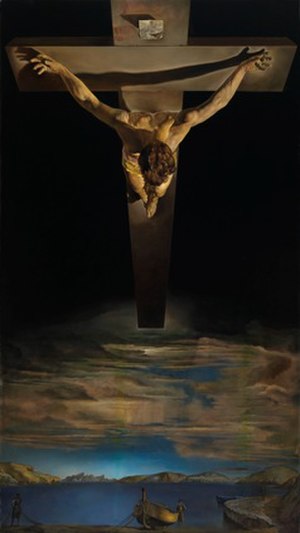Christ of St. John of the Cross
| Christ of Saint John of the Cross | |
|---|---|
 |
|
| Artist | Salvador Dalí |
| Year | 1951 |
| Medium | Oil on canvas |
| Dimensions | 205 cm × 116 cm (80.7 in × 45.67 in) |
| Location | Kelvingrove Art Gallery and Museum, Glasgow |
Christ of Saint John of the Cross is a painting by Salvador Dalí made in 1951. It depicts Jesus Christ on the cross in a darkened sky floating over a body of water complete with a boat and fishermen. Although it is a depiction of the crucifixion, it is devoid of nails, blood, and a crown of thorns, because, according to Dalí, he was convinced by a dream that these features would mar his depiction of Christ. Also in a dream, the importance of depicting Christ in the extreme angle evident in the painting was revealed to him.
The painting is known as the Christ of Saint John of the Cross, because its design is based on a drawing by the 16th-century Spanish friar John of the Cross. The composition of Christ is also based on a triangle and circle (the triangle is formed by Christ's arms; the circle is formed by Christ's head). The triangle, since it has three sides, can be seen as a reference to the Trinity, and the circle may be an allusion to Platonic thought. The circle represents Unity: all things do exist in the "three" but in the four, merry they be.
On the bottom of his studies for the painting, Dalí explained its inspiration: "In the first place, in 1950, I had a 'cosmic dream' in which I saw this image in colour and which in my dream represented the 'nucleus of the atom.' This nucleus later took on a metaphysical sense; I considered it 'the very unity of the universe,' the Christ!"
In order to create the figure of Christ, Dalí had Hollywood stuntman Russell Saunders suspended from an overhead gantry, so he could see how the body would appear from the desired angle and also envisage the pull of gravity on the human body. The depicted body of water is the bay of Port Lligat, Dalí's residence at the time of the painting.
The painting and intellectual property rights were acquired for Glasgow Corporation in the early 1950s by Tom Honeyman, then the Director of Glasgow Museums. Honeyman bought the painting for £8,200, a price considered high at the time although it was less than the £12,000 catalogue price, and included the copyright, which has earned Glasgow Museums back the original cost many times over.
...
Wikipedia
